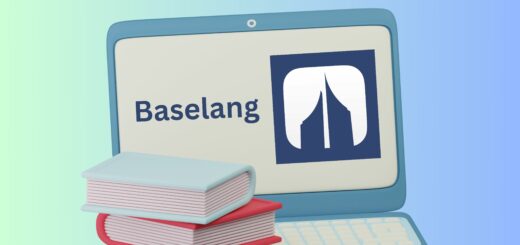Ling Review 2024: Should You Choose It? (Course Overview and Alternatives)
While learning a language, I learned about the Ling app from my friends. Although I have never tried it, there were mixed Ling app reviews online. Undoubtedly, there was no chance of making my decision based on those reviews. So, recently, I thought of giving it a try. I am sure you must have gone through the same problem and are waiting for a genuine and unbiased opinion of it. Don’t worry. Being a language learner, my only dream is to give other learners the right opinion. Thus, I will share everything about the app in this Ling review.
So, what are you waiting for? Just dive in and see if it is really the right choice for you.
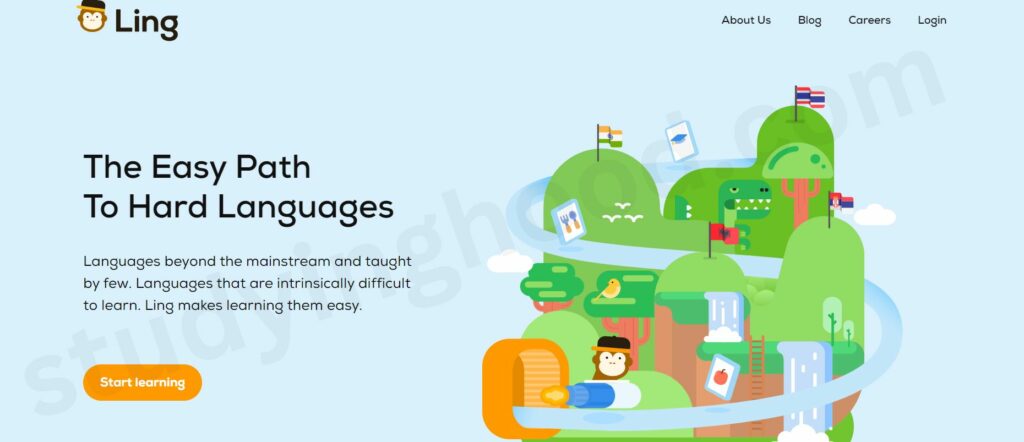
What is the Ling app?
Ling is a language learning platform developed in Thailand. Naturally, it means there are a lot of Asian languages. The platform follows a gamified approach where learning. Language is through mini-games. Not only games but there are a lot of native audio lessons. The way it helps to learn vocabulary is easy. Some cute pictures and audio help to learn the language. I believe it’s like a Duolingo clone. Anyone who wants to learn the language is welcome on Ling. It does not matter whether you are a beginner an advanced level, there are lessons for each type of person.
What are the language available on Ling App?
Knowing the languages available on a language learning platform is very important. There are 61 languages in Ling, which I have mentioned below-
| English | Armenian | Cantonese | Catalan | Dutch |
| French | Arabic | Bulgarian | Estonian | Georgian |
| Afrikaans | Bengali | Croatian | Chinese | Danish |
| Albanian | Bosnian | Burmese | Czech | Finnish |
| Indonesian | Malayalam | Italian | Latvian | Kannada |
| Khmer | Greek | Lao | Hindi | Lithuanian |
| German | Irish | Hebrew | Japanese | Hungarian |
| Malaysian | Korean | Polish | Nepali | Mongolian |
| Norwegian | Serbian | Marathi | Portuguese | Slovenian |
| Russian | Persian | Romanian | Slovak | Punjabi |
| Thai | Telugu | Swahili | Tagalog | Tamil |
| Spanish | Turkish | Urdu | Ukrainian | Swedish |
| Vietnamese |
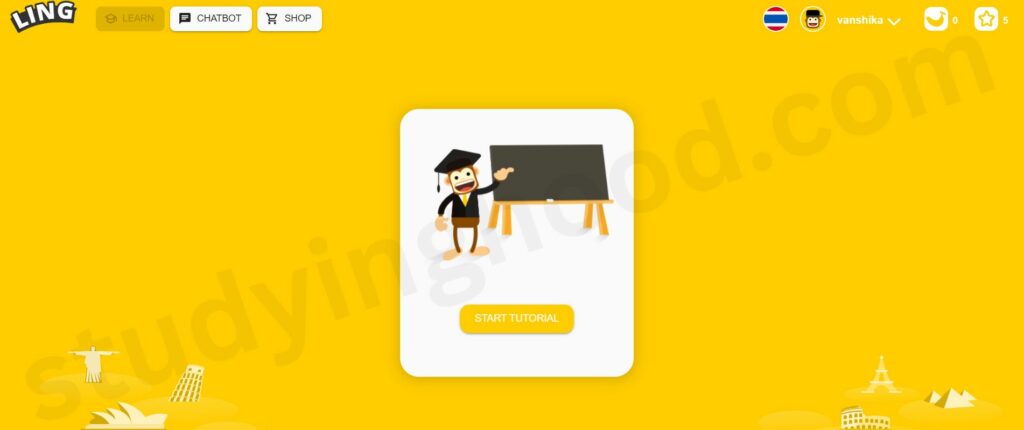
What is the cost of using the Ling App?
There are three types of plans that you get on this platform. The following table shows the cost for each of the plans-
| Monthly | Annually | Lifetime |
| $14.99 per month | $79.99 per year ($6.66 per year) | $149.99 |
Now which plan will work best for you? First, ask yourself these questions-
- Do you only want to learn a single language?
- Will you stop learning the language after one month?
Now, based on the answer you get, here I have mentioned which plan to take on-
1. Monthly Plan
If the answer to the last question is a yes, go for the Monthly plan. But if you are seriously thinking about learning the language and will not stop after a month, forget about the monthly plan.
2. Annual Plan
If the answer to the first question is a yes, you must choose an annual plan. Try to understand that learning a new language takes effort. If you are learning a single lesson a day, it will take 5-6 months depending upon the speed. Thus, choosing an annual plan gives you the flexibility to complete it at your own pace.
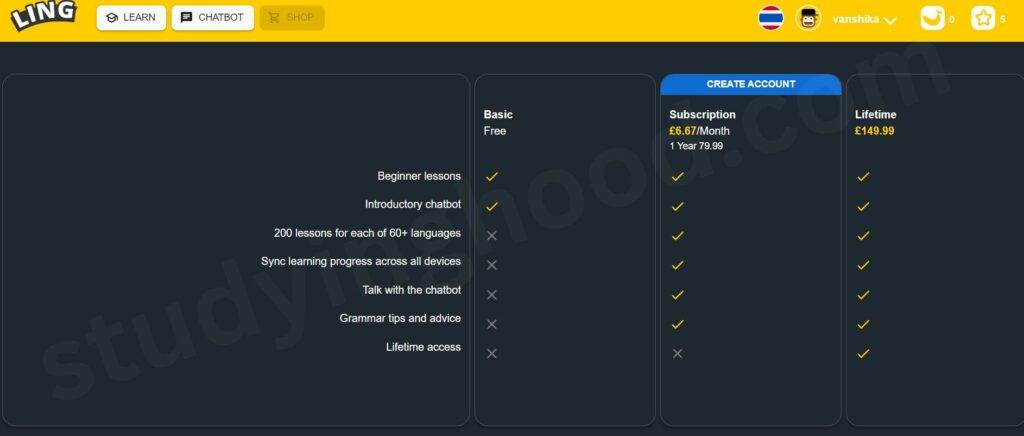
3. Lifetime Plan
Choosing this plan is only worth it if you want to learn more than one language. Thus, if the answer to the first question is no, go for this plan. I myself have taken this plan. It is because I keep using different platforms to develop my knowledge.
Is there a free trial period?
When I first used Ling, the first two units were free to try. I thought it was because I was a new user of it. But my friend told me that the first two units of each language are free. However, if you take an annual subscription plan, you also get a 7-day free trial. It will help you to decide if it is worth using or not.
How to start with the Ling app?
Here are the steps to start with Ling App-
- When you open the official platform, you must create a profile by giving answers to basic questions. It will take some time.
- When done, a new window will be shown, having a message about preparing the path for you.
- After that, there will be a sign-up page. Fill out the details and click on the Signup option.
- Now there will be a plans page. Choose the plan you want and click on get my plan.
- Fill in the card details, and click on submit.
Remember: If you are taking the annual plan and no longer want it, cancel the plan before the free trial is over.
Ling Review: Course Overview
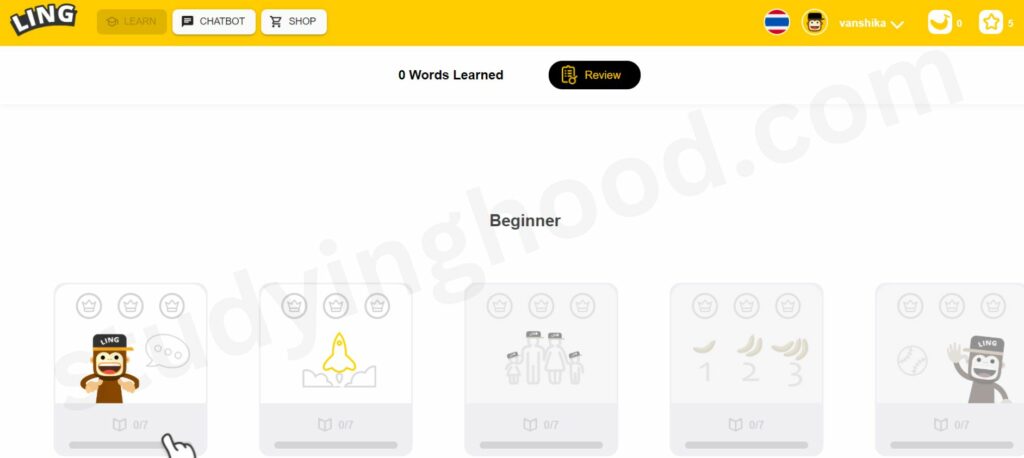
Of Course, before choosing the platform, it is vital to know how the course is created. There are a total of 50 units which were divided into 5 sections, as mentioned before. Each unit has a set of four lessons which means 200 lessons in total. Going through these lessons, I got specific vocabulary through interactive lessons. Even if you get to learn 5 new words in a lesson, it becomes 1000 words to learn in a language. Further, I have discussed each aspect of the course in Detail.
1. Lessons and exercise
As there are around 400 lessons, it is important to know what we will get out of it. When I selected the unit, four theme lessons showed what was there in each lesson. There are three rounds to practice in it. In the beginning, there was a translation of the words and example sentences. Also, there is a pre-recorded audio where you can listen to native speakers. One thing that is different from other platforms was, I could really have a slowed version of audio.
After reading and listening to the audio, there is a practice session. In this session, there are different types of exercises-
- Spelling activity
- A matching task
- A sentence-ordering exercise
- Multiple-choice questions
These exercises are too easy, even a beginner can complete them easily. There are no detailed explanations needed. All the lessons are short and a great way to teach your language.
2. Dialogues
In the end, there are a lot of Dialogues in the lessons. These dialogues help to test what you have learned in the lessons. Of Course, it is a tough yet exciting feature of the app. The dialogues teach you the vocabulary in a way that there is a conversation between two native speakers. In these dialogues, you also get to fill in exercises. Each dialogue has translations with it. However, there may be no translation of a single word. Some languages may have more grammar explanations than others.

3. Exams
From the name itself, you must have an idea about what it would be. They are like a final practice to test if you have completely learned the lesson. The only difference between the exams and lesson exercises is that the exam exercises are based on a heart system. Four hearts represent your four chances to correct your mistakes. If you are unable to do so, you will fail.
4. Review and review all
Let me show you both the features one by one. Firstly, 10 random rounds cover questions from any unit you have covered so far if I talk about review features. It works like the Exam but there is no timer in it. I think to make it more efficient, the platform should keep a timer and include the Spaces Repetition System (SRS). This can help us keep the track in mind.
The other one is Review All. In this section, there is a dictionary for the words encountered so far. According to me, it can be improved a lot to give a better experience to the learners. I believe making it a searchable dictionary will be a better decision. At present, if I want a meaning of the word, I have to search it by units. It is very time-consuming.
5. Speaking practice
When I was in the Japanese course, I used this feature. All I had to do was listen to the audio and repeat it. There is a speech recognition technology that tests my pronunciation. What I don’t like about this is there is no feedback. When you are trying something new, you need feedback to understand where you are lacking. However, it highlights specific sounds that make it easy to understand the right pronunciations.
6. Writing practice
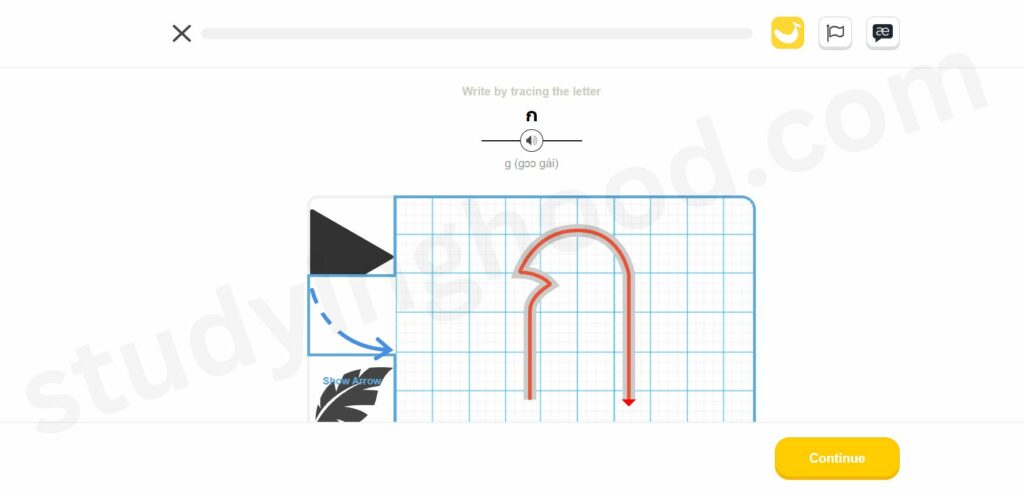
The major thing that I like on this platform is the writing practice. As Japanese has a different writing style, I wanted to check how it works. In it, there is an animated character. The platform asked me to trace it with arrows. When it was done, I was asked to practice on my own. I really enjoyed practicing the characters. There is also a practice session for Vietnamese. One of my friends is learning it through Ling. As the language used different writing styles, he could learn them easily.
What shocked me was there is no writing section for the Chinese language. It may be because teaching many unique characters is a big task.
7. Chatbot
If you think it works like other chat boxes, where you connect with real people, you are wrong. Chatbot is a bot with which you have to chat. When I was using it, there were two characters, and I had to choose one. Then there are pre-made responses that I need to select for a dialogue made by the bot. It was very entertaining with the more advanced level. However, many sentences had a bug in it. In one of the cases, I got 3 similar options. You can also record yourself speaking the responses to get smooth speaking practice.
Should you choose Ling to learn the language?
Ling focuses on all 4 skills which makes it a perfect choice. But do you know the best part? There are no specific number of practices available. Also, all the activities are enjoyable and use native speakers’ audio to practice. However, there are not so many grammatical explanations. Here is a table that quickly different what I liked and disliked about the Ling app-
| What I Like About It? | What I Don’t Like About It? |
|---|---|
| It helps to focus on 4 skills. | Most of the modules are for absolute beginners. |
| There are audios used by native speakers. | Most of the modules are from absolute beginners. |
| All the activities are enjoyable. | Some activities are very buggy. |
| The price is very decent. | No translations with individual words. |

Alternatives
I always believe we should use more than 1 platform to learn the language. I have shared some alternatives that you can use along or instead of Ling. Here, are some of them-
1. Duolingo
Ling is a gamified platform for learning a language. Undoubtedly, Duolingo is a well-known platform that follows the gamified approach. All the activities are so interesting. Just like Ling, there is a heart system that is only available on mobile apps. If you are a beginner, I am sure you will enjoy this platform the most.
2. uTalk
uTalk is a platform that has courses to learn a specific language. There are over 140 language courses that I could think of. Just like Ling, there are native speaker audio and interactive games like exercises. However, it is a better alternative if you are on a tight budget. The monthly subscription is less than $4 per month, for a single language. Thinking about why the price is so low? It is because there is no writing exercise.
3. Anki
It is a flashcard app where you can create your own flashcard deck or use others. This is a perfect platform for those who want to learn the language in a fun manner. I recommend you use this platform along with Ling. Get the vocabulary list and add them to Anki. You will get a spaced repetition system to learn the words on the platform.
4. Preply
If you are looking for a platform to get live classes, Preply is for you. I enjoyed the fact that I got a lot of tutors to teach the language. It gave me a chance to have a demo session with multiple teachers. Some teachers were not up to my expectations but most of them did a great job. I finally chose one and built up a long-term relationship with her. Overall the experience was really great. However, the only thing I didn’t like was the pricing style. The tutors I liked had a high pricing. However, you can filter your search based on your budget.
Conclusion
The Ling app is the one that follows the gamified approach. All the exercises were amazingly created and kept me engaged with the content. There was also an exam section where I got a chance to test how much I had learned in the language. There are around 61 languages on the Ling app. To start with the course, I had to choose the subscription plan first. There are three types of plans on the platform. If you think the platform is not the right choice to start with, try Duolingo or Anki.
FAQs
Is Ling trustworthy?
Undoubtedly, Ling is a trustworthy platform with a growing number of active users. The current increase in the number of active users was 489% in 2023.
Is Ling worth paying for?
Trust me, it depends upon which plan you are thinking of taking up and how many languages you want to learn. I have taken the lifetime plan. It is simply because I keep learning multiple languages.

